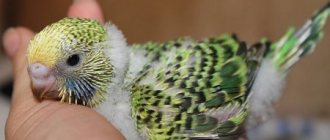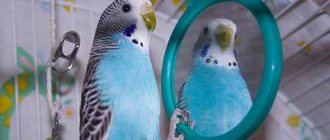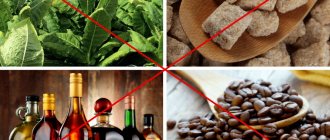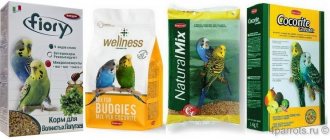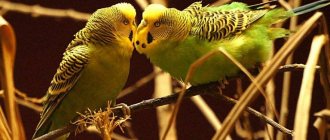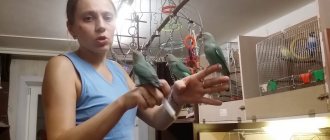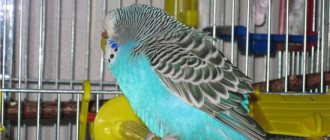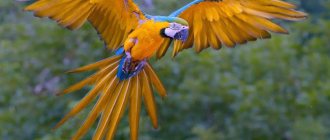Caring parents for parrot chicks are a guarantee that the birds will grow up healthy and adapted to the surrounding conditions. But there are situations when female budgerigars refuse to raise their young or die from complications during egg laying.
In this case, a defenseless chick or several individuals at the same time may end up in the owner’s arms. Without human help, this tiny creature will not live even a day. That is why it is worth knowing how to feed a budgerigar chick yourself.
What to feed the chicks
In one year, a female can give birth 4 times, which depends on the conditions created for her. The usual offspring of a bird is approximately 3-5 eggs. The young feed on a liquid organic substance, which is prepared by the female. A mixture rich in milk protein is formed in the stomach and crop of the latter.
It is also useful to read: Budgerigar eggs
Natural feeding
As soon as the chicks are born, they are completely dependent on their parents.
Regardless of the number of babies and their age, the female pays equal attention to each: she turns them over for feeding and gives them nutritional mixture through her beak.
If the bird received a sufficient amount of food, as well as minerals and vitamins, then there will be no problems with feeding the chicks. As the young grow older, the female dilutes the liquid mixture with grains. The combined food goes to the grown chicks, and those who hatched last get pure protein milk.
In addition to the female, the male can also do the feeding. Its crop is also adapted for preparing nutritional mixtures. As a rule, if there are fewer than five chicks, the male does not participate in feeding.
The female feeds the young for 1-2 months, after which they fly out of the nest and become completely under the care of the father. As soon as the last chick leaves the house, the mother begins to prepare for the next clutch.
Do you give your parrot fruit?
Not really
Artificial feeding
It happens that the female completely abandons her offspring and the bird’s owners must take on the role of mother and feed the newborn chicks. Moreover, the refusal also applies to the male. He will never approach the young if the female has done the same.
Reasons for feeding budgerigar chicks:
the offspring is too large - more than 7-10 eggs;- underdeveloped or completely absent maternal instinct in the female;
- the man picked up the chick;
- lack of appetite in young animals due to illness or other reasons;
- the female is already preparing the next clutch;
- absence of parents.
Chicks cannot go without food for more than 12 hours. In the absence of a nutrient mixture, they will simply die of hunger. Therefore, you need to prepare it in advance.
First of all, the chicks need to organize an optimal microclimate. The thermometer in the room with young animals should not fall below +25⁰С or rise above +35⁰С. You can create something like a nest from almost anything, even from a cardboard box.
But it’s best to look towards factory incubators. There are small, yet inexpensive solutions for a dozen pets on sale. Starting from the third week of life, the thermoregulation of the chicks’ body begins to return to normal and they do not require heating as such.
Basic principles of nutrition for budgies
The food must contain proteins that ensure vital functions and participate in various metabolic processes. To maintain energy and form fat, carbohydrate intake is important. A large role is given to vitamins A, D, E, K, group B and others.
Minerals are involved in the formation of egg shells and skeletal bones. Their birds are obtained from greens, fruits, and mineral supplements. The necessary components include water.
What can you give a budgie besides food list
All elements must be supplied in a certain balance. Both a deficiency and an excess of one of them not only causes a disruption in the functioning of the body, but also leads to improper absorption of other substances and illness of the feathered friend.
The type and amount of food in the diet depend on the parrot’s age and activity. Thus, individuals living in cages require less of it than when kept in an enclosure.
Type of feed
After equipping the incubator, you should think about choosing the type of feed. You can organize the nutrition of young animals in different ways. It’s good if the feeding is combined, then the chick will definitely receive all the nutrients necessary for the growing body.
Donor bird
This option is very often adopted by experienced breeders. The finished mixture is pumped out from the crop of another female and given to the chick through a catheter . At the same time, the baby receives natural and nutritious food. The method is quite labor-intensive and in some cases even dangerous, so it is not suitable for beginners.
Malt milk
You will need sprouted grain feed. It is crushed using a pestle and mortar or any other convenient method, then filtered, and then mixed with water and a fresh chicken egg. You should have a porridge-like consistency.
The food is heated to +40⁰С and given to the baby . If the feed temperature is too low, the mixture begins to ferment in the crop and, as a result, the bird experiences severe discomfort. Hot food can cause burns to the chick's still tender tissues.
Porridge with enzymes
Chicks often have problems with the gastrointestinal tract. Therefore, many breeders recommend feeding young animals with liquid porridges, mixing the preparations “Festal” and “Mezim” into them. Such porridges can also be combined with malted milk.
Industrial mixtures
This is one of the simplest, but at the same time financially expensive methods. Specific store-bought feed in the “for chicks” format contains all the necessary elements. Here we have minerals, vitamins, enzymes and other nutrients that increase the bird's immunity, as well as strengthen its bones and feathers.
This kind of food can be compared to the natural food that the baby receives from the female. Budget solutions can be used as supplements, while premium mixtures are suitable as the main diet. Among others, NutriBird A19 and A21 receive particularly warm reviews.
Dairy-free porridge
In this case, the mixtures are prepared without adding milk: salt and sugar are also excluded. Regular porridges are suitable: buckwheat, oatmeal or corn. Food must be heated, but not above +40⁰С.
By the fourth day of life, beet, carrot and pumpkin extracts can be gradually included in the diet. After two weeks, small pieces of fruit are mixed into the food: apple or banana. You can also add low-fat cottage cheese.
Water
The chick does not need water due to the abundance of liquid mixtures. An exception may be particularly hot summer days, when the air temperature rises above +40⁰С. A regular need for water will appear only after switching to dry food.
It is also useful to read: Homeland of budgerigars
Approximate weekly rations (by time of year) for birds without offspring
Feeding parrots in spring
- Day 1 – grain mixture, wet mixture “A”, millet and oat seedlings.
- Day 2 - wet mixture “B”, grain mixture, cookies, pine needles, oat or millet sprouts, finely grated beets.
- 3rd day - wheat grains sprouted without soil, grain mixture (full daily norm), oats, millet seedlings, add cottage cheese to the grain mixture.
- Day 4 - wet mixture "A", grain mixture, grated beets instead of water, herbal meal or dried nettle.
- 5th day - rosehip decoction, grain mixture, bread or crackers soaked in tea with honey or milk, steamed corn, nuts, oat shoots.
- Day 6 - wet mixture "B", grain mixture, steamed oats, grass flour, pine needles - into the grain mixture.
- Day 7 - sprouted wheat grains without soil, grain mixture (full daily allowance), tangerine or orange slices, rosehip decoction - instead of water.
- Once or twice a week, the birds are given fasting days, on which they are given only a grain mixture (full daily allowance) and greens.
- On other days, the norm of the grain mixture in the diet is reduced by 1/4.
Feeding parrots in summer
- Day 1 - roll or white bread soaked in tea with sugar or honey, grain mixture, cottage cheese, dandelion, woodlice or clover leaves.
- Day 2 – wet mixture “A”, grain mixture, lettuce or spinach.
- Day 3 - slices of fresh cucumber or tomato, grain mixture (full daily value), dandelion leaves.
- Day 4 - wet mixture "B", grain mixture, apple slices, dandelion leaves or unripe plantain spikelets.
- Day 5 - wet mixture “B”, grain mixture, grated carrots, nuts, woodlice leaves, dandelion.
- Day 6 - wet mixture “B”, grain mixture, white crackers soaked in milk, dandelion leaves, spinach.
- Day 7 - nuts, berries, grain mixture (full daily allowance), cabbage leaves, lettuce.
Feeding parrots in autumn
- Day 1 - wet mixture “A”, grain mixture, cabbage leaves, wild berries.
- Day 2 - white bread or roll soaked in milk, grain mixture, slices of apple, watermelon or melon, grapes.
- 3rd day - wheat grains sprouted without soil, grain mixture (full daily norm), cabbage leaves, spruce needles.
- Day 4 - apple or pear slices, grain mixture, rowan berries.
- Day 5 - wet mixture “B”, grain mixture, nuts, cottage cheese, cabbage leaves.
- Day 6 - dry cookies, grain mixture, white crackers soaked in tea with sugar or honey, grated carrots, apple or pear slices.
- Day 7 - nuts, spruce needles, grain mixture (full daily allowance), sprouted wheat grains without soil, cabbage leaves.
Feeding parrots in winter
- Day 1 - wet mixture “A”, grain mixture, young oat shoots, steamed corn, millet.
- 2nd day - oat or millet sprouts, grain mixture (full daily norm), wheat grains sprouted without soil, dried nettle or grass flour - into the grain mixture.
- Day 3 - wet mixture “B”, grain mixture, roll soaked in milk or tea.
- 4th day - wet mixture “A”, grain mixture, apple slices, rosehip decoction - instead of water, pine needles, herbal flour.
- 5th day - wet mixture “B”, grain mixture, nuts, oat sprouts, steamed corn or peas, millet, grain mixture (full daily norm), wheat grains sprouted without soil, pine needles, grated carrots, oat sprouts, rosehip decoction - instead of water.
- Day 6 - wet mixture "A", grain mixture, finely grated beets, herbal flour - into the grain mixture
Feeding equipment
Two-day-old chicks are given food through a special tube - cannula . You can buy it at a pet store or pharmacy. The end of the tube is pushed as close to the stomach as possible so that food does not enter the trachea during feeding. If the chick is not weakened, then it will eat actively.
Remains of food stuck to the beak must be removed without fail. When there are many chicks, the female may not have time to free the baby’s paws from droppings and food. They should also be cleaned. Otherwise, there is a risk of dangerous microorganisms and parasites appearing.
If food is stuck under the beak, it must be removed with a toothpick. Two-week-old pets can already be fed with a syringe without a cannula. Food must be fed not into the beak, but into the crop, so that the chick does not choke on the mixture.
As soon as one chick learns to feed on its own, the remaining members of the group will immediately follow his example. Therefore, when training, it is sometimes more practical to concentrate on one most intelligent pet.
How often should babies be fed?
When the young animals appear, they need to be fed every couple of hours during the day and once every 4 hours at night. The interval between meals increases gradually as the chick grows older. By the tenth day, the bird should eat 6 times a day.
From the third week of life, food is given 4 times a day . After a month, you need to switch to three meals a day. If the bird is hungry, it will begin to squeak, so you need to listen to the sounds coming from the cage.
One and a half month old chicks acquire feathers and stop vocalizing when they want to eat. It is very important to follow the regime and give food to your pet even if he doesn’t want it. If the young animals are sick, they should be fed more often.
When can you switch to adult food?
By the seventh week of life, you can stop caring for the chicks. They eat on their own, become fully feathered, and attempt to fly. During this period, you should gradually add dry food to the diet, while not forgetting to give your pet water.
A sure sign that it’s time to switch to adult food is the bird’s confident grip . If the bird feels good on the perch or on the owner’s finger and does not lose its balance, then this means that the chick has matured.
Adult food also includes fruits and vegetables. You can no longer grind them into a pulp, but simply cut them into pieces. Mixtures in a liquid consistency are given to sick birds experiencing problems with the gastrointestinal tract or with a weak immune system.
Development by day
To understand how small wavy plants grow and develop, the following stages are taken into account:
- in the first three days the chicks are completely helpless, and they also lack plumage;
- on the sixth day, their egg tooth, which is necessary for breaking the shell, falls off, so from this moment the birds can raise their heads;
- a week after birth, the birds’ neck muscles become stronger, so they can easily hold their heads up, and also gradually open their eyes and try to sit up;
- on the 10th day, their gaze becomes more meaningful, and they also begin to clearly see surrounding objects;
- two weeks after birth, the first feathers appear on the back of the head and wings;
- by the end of the third week, the birds acquire full plumage with a specific color;
- after a month, the birds have an elongated tail, and the owner can determine the sex of each chick;
- after 40 days the birds begin to fly a little.
Wavys develop very quickly after birth. Although a person participates little in this process, he must provide optimal external conditions.
Particular attention is paid to nutrition, since the female not only eats on her own, but also feeds her offspring. Literally a month later the birds are not much different from their parents. The differences are only in the size of the body and plumage.
Useful tips
If the cage acts as an incubator, then the drinking bowl and bathing bowl must be removed from it. Small chicks may accidentally choke or drown in containers. Any sharp objects or abrasive elements, such as concrete perches, should also be removed to prevent injury.
Recommendations for beginners:
There is no point in stocking up on mixtures for future use. The dose per chick is about 5 ml. Natural liquid food spoils very quickly, and sour food can cause serious poisoning.- There is no need to feed the young animals. The chick will receive the required amount of water along with cereals and other liquid food.
- Starting from the seventh day of life, the pet’s diet must be diversified with fruit juices. If you’re too lazy to cook them yourself, you can buy baby food.
- Birds need minerals to strengthen their bones. You can find them in eggshells and chalk. But the main thing here is not to overdo it, because an excess of minerals will have a detrimental effect on your pet’s health.

